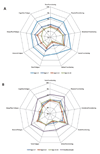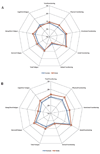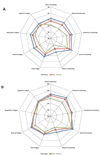Health-related quality of life in children with sickle cell disease: a report from the Comprehensive Sickle Cell Centers Clinical Trial Consortium
- PMID: 20658620
- PMCID: PMC2911637
- DOI: 10.1002/pbc.22497
Health-related quality of life in children with sickle cell disease: a report from the Comprehensive Sickle Cell Centers Clinical Trial Consortium
Abstract
Background: Pediatric health-related quality of life (HRQOL) questionnaires have been validated in children with sickle cell disease (SCD), but small sample sizes in these studies have limited clinical comparisons. We used the baseline clinical data from the Collaborative Data (C-Data) Project of the Comprehensive Sickle Cell Centers (CSCC) Clinical Trial Consortium to perform a detailed, descriptive study of HRQOL using the PedsQL version 4.0 generic core and fatigue scales.
Methods: Retrospective clinical data were obtained via medical record abstraction. Staff-administered health history, psychosocial, and health behavior interviews were completed by a parent or guardian. PedsQL forms were completed separately by the child and a parent/guardian.
Results: The study enrolled 1,772 subjects (53% boys) with a mean age of 9.6 years (SD 4.7). SS or Sbeta(0) thalassemia occurred in 68% and 32% had SC or Sbeta(+) thalassemia. The occurrences of pain, priapism, avascular necrosis of hips/shoulders (AVN), or asthma were the most common complications/conditions reported. Multiple regression models controlling for hemoglobinopathies, gender, and age suggested that parent reports of physical functioning and sleep/rest fatigue declined in response to pain or AVN, while school functioning scales declined in response to pain or asthma. Sickle pain, and to a lesser extent asthma, negatively influenced child reports on almost all functioning and fatigue scales.
Conclusions: While longitudinal studies will be necessary to determine sensitivity to change, the current study suggests the potential utility of several PedsQL HRQOL scales as patient-reported outcome measures for observational or interventional treatment studies of children and adolescents with SCD.
2010 Wiley-Liss, Inc.
Figures



Similar articles
-
Health-related quality of life in adults with sickle cell disease (SCD): a report from the comprehensive sickle cell centers clinical trial consortium.Am J Hematol. 2011 Feb;86(2):203-5. doi: 10.1002/ajh.21905. Am J Hematol. 2011. PMID: 21264908 Free PMC article.
-
Cognitive functioning, patient health communication, and worry mediate pain predictive effects on health-related quality of life in youth with sickle cell disease.Pediatr Blood Cancer. 2020 Nov;67(11):e28680. doi: 10.1002/pbc.28680. Epub 2020 Aug 29. Pediatr Blood Cancer. 2020. PMID: 32860648
-
Health-related quality of life in children and adolescents with sickle cell disease.J Pediatr Health Care. 2011 Jul-Aug;25(4):208-15. doi: 10.1016/j.pedhc.2009.12.006. Epub 2010 Apr 2. J Pediatr Health Care. 2011. PMID: 21700135 Free PMC article.
-
Folic acid supplementation and malaria susceptibility and severity among people taking antifolate antimalarial drugs in endemic areas.Cochrane Database Syst Rev. 2022 Feb 1;2(2022):CD014217. doi: 10.1002/14651858.CD014217. Cochrane Database Syst Rev. 2022. PMID: 36321557 Free PMC article.
-
Health-related quality of life in hemoglobinopathies: A systematic review from a global perspective.Front Pediatr. 2022 Aug 25;10:886674. doi: 10.3389/fped.2022.886674. eCollection 2022. Front Pediatr. 2022. PMID: 36090573 Free PMC article.
Cited by
-
Use of consumer wearables to monitor and predict pain in patients with sickle cell disease.Front Digit Health. 2023 Oct 25;5:1285207. doi: 10.3389/fdgth.2023.1285207. eCollection 2023. Front Digit Health. 2023. PMID: 37954032 Free PMC article.
-
Sleep and fatigue among youth with sickle cell disease: A daily diary study.J Behav Med. 2023 Jun;46(3):440-450. doi: 10.1007/s10865-022-00368-5. Epub 2022 Nov 5. J Behav Med. 2023. PMID: 36334167 Free PMC article.
-
What is the future of patient-reported outcomes in sickle-cell disease?Expert Rev Hematol. 2020 Nov;13(11):1165-1173. doi: 10.1080/17474086.2020.1830370. Epub 2020 Oct 15. Expert Rev Hematol. 2020. PMID: 33034214 Free PMC article. Review.
-
Association between Participants' Characteristics, Patient-Reported Outcomes, and Clinical Outcomes in Youth with Sickle Cell Disease.Biomed Res Int. 2018 Jul 18;2018:8296139. doi: 10.1155/2018/8296139. eCollection 2018. Biomed Res Int. 2018. PMID: 30105252 Free PMC article.
-
Insurance status as a sociodemographic risk factor for functional outcomes and health-related quality of life among youth with sickle cell disease.J Pediatr Hematol Oncol. 2014 Jan;36(1):51-6. doi: 10.1097/MPH.0000000000000013. J Pediatr Hematol Oncol. 2014. PMID: 24136028 Free PMC article.
References
-
- Chiang EY, Frenette PS. Sickle cell vaso-occlusion. Hematol Oncol Clin North Am. 2005;19:771–784. - PubMed
-
- Castro O, Gladwin MT. Pulmonary hypertension in sickle cell disease: mechanisms, diagnosis, and management. Hematol Oncol Clin North Am. 2005;19:881–896. - PubMed
-
- Shapiro BS, Dinges DF, Orne EC, et al. Home management of sickle cell-related pain in children and adolescents: natural history and impact on school attendance. Pain. 1995;61:139–144. - PubMed
-
- Dampier C, Ely B, Brodecki D, O'Neal P. Characteristics of pain managed at home in children and adolescents with sickle cell disease by using diary self-reports. J Pain. 2002;3:461–470. - PubMed
Publication types
MeSH terms
Grants and funding
LinkOut - more resources
Full Text Sources
Medical

